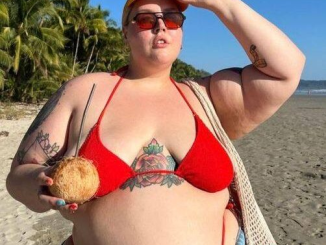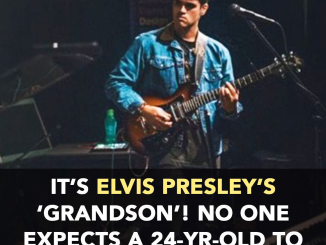In a dramatic unveiling that has left the public and critics buzzing, King Charles III revealed his first official portrait since ascending to the throne, and reactions have been anything but tepid. As debates rage on social media and in art circles, it is clear that King Charles’ portrait is destined to be one of the most talked-about royal artworks in recent history.
The unveiling

Recently, King Charles III personally unveiled a new portrait of himself at Buckingham Palace, the first such portrait since his coronation. The Royal Family’s Instagram account shared an exclusive video of the unveiling, featuring the king himself presenting the artwork.
This significant new work will ultimately be displayed in Drapers’ Hall in London, adding to its historical art collection and offering the public a glimpse of the monarch’s regal presence.
There was an ongoing debate in the comments.

The unveiling sparked a heated debate in the comments section on the Royal Family’s Instagram post and other social media sites. Opinions were sharply divided, with some users harshly criticizing the artwork. Comments ranged from “That is hideous” and “Without sounding rude, this is the worst royal portrait I’ve ever seen” to “100% thought this was satire.”
One critic remarked, “The face is good, the rest is appalling,” while another noted, “I would have loved this if it was any other color than red. He really captured the essence of him in the face, but the harshness of the red doesn’t match the softness of his expression.”
Despite the criticism, there were also voices of appreciation, such as “A lovely portrait of King Charles! I love the way the muted background draws attention to his face!” The mixed reactions highlight the polarizing nature of the portrait and the strong emotions it has evoked among the public.
The artist
Jonathan Yeo, a prominent figure in the world of figurative painting, has earned widespread acclaim for his unique blend of traditional and experimental portraiture. Yeo’s distinctive approach involves a deep engagement with his subjects, allowing him to capture their essence beyond mere physical appearance.
His recent portrait of King Charles III epitomizes this philosophy. Yeo explained, “As a portrait artist, you get this unique opportunity to spend time with and get to know a subject, so I wanted to minimize the visual distractions and allow people to connect with the human being underneath.”
The meaning of the portrait.
A particularly striking element of Yeo’s portrait is the inclusion of a butterfly. This detail serves multiple purposes, both symbolic and compositional. Yeo elaborated, “Primarily a symbol of the beauty and precariousness of nature, it highlights the environmental causes the King has championed most of his life and certainly long before they became a mainstream conversation.”
The butterfly also provides a visual contrast to the uniform, softening the portrayal and adding layers of meaning. “In the context of art history, a butterfly often symbolizes metamorphosis and rebirth, paralleling the King’s transition from Prince to monarch during the period the portrait was created,” Yeo noted, further emphasizing the transformative phase in King Charles’s life.

Yeo expressed his gratitude and honor for being commissioned to create such a significant portrait. “It was a privilege and pleasure to have been commissioned by The Drapers’ Company to paint this portrait of His Majesty The King, the first to be unveiled since his Coronation.”
Yeo’s approach to portraiture aims to encapsulate the life experiences and humanity etched into his subjects’ faces. “I do my best to capture the life experiences and humanity etched into any individual sitter’s face, and I hope that is what I have achieved in this portrait,” he explained.
The challenge of portraying a figure as complex and significant as King Charles III was substantial, but one that Yeo found immensely rewarding. “To try and capture that for His Majesty The King, who occupies such a unique role, was both a tremendous professional challenge, and one which I thoroughly enjoyed and am immensely grateful for,” he concluded. The portrait, destined for Drapers’ Hall in London, stands as a testament to both the artist’s skill and the monarch’s enduring legacy.
Discover the lesser-known facets of King Charles III’s life in our compelling article, “8 Things About King Charles III That Will Allow Us to Know Him More Closely.” Dive beyond the regal exterior to uncover intimate details about his passions, personal experiences, and unique quirks.
Preview photo credit Kin Cheung / Associated Press / East News, theroyalfamily / Instagram, jonathanyeo / Instagram
The Great Ketchup Debate: To Refrigerate or Not to Refrigerate?

It can be really confusing to walk through the aisles of our favorite grocery shop and figure out what food items require refrigeration and what doesn’t.
It is reasonable to believe that if a product isn’t refrigerated in stores, it also doesn’t need to be at home. That isn’t always the case, though.
A modest word in fine type can be found on the labels of many products on grocery store shelves if we look closely: “refrigerate after opening.” Sadly, not everyone takes note of this small directive, and even those who do sometimes decide to disregard it. Ketchup is an excellent illustration of this.
The popular ketchup brand, Heinz, actually advises chilling their product as soon as you bring it inside. You may be asking yourself, “But why does ketchup need to be refrigerated when I see bottles of it sitting on the store shelves?” Heinz wants you to know that it’s all for the best, though.

This ketchup conundrum intrigued me, so I decided to look into it directly. I grabbed a bottle of Heinz ketchup from my own kitchen and read the label carefully. And there it was—the warning to “For best results, refrigerate after opening”—subtly printed in small text on the label on the reverse. Thus, the recommendation is clear: refrigeration is advised.
Were you aware that Heinz addressed this issue on Twitter as well? The message on their short tweet said, “FYI: Ketchup goes in the fridge!!!” This tweet grabbed the attention of people all over social media and started a heated debate among ketchup lovers.

Heinz even went so far as to survey people about how they keep their ketchup in storage at home. The outcomes were really intriguing. Of all the people who use ketchup, 36.8% keep it in a cabinet and 63.2% keep it in the refrigerator.
It’s intriguing to learn the motivations behind some people’s decisions to disregard refrigeration recommendations. They contend that ketchup tastes good even when kept at room temperature and that it doesn’t spoil readily. The good news is that you can keep your ketchup fresher for longer by refrigerating it, which will increase its shelf life.

Thus, keep in mind what Heinz suggests if you’re still not sure if you should refrigerate your ketchup. And why not follow the rest of us and store that bottle of ketchup in the refrigerator, nice and cold? It’s a simple method to guarantee that your favorite condiment remains flavorful and fresh.
It’s your time to comment on the ketchup controversy now! Which is better for storing ketchup—in a cupboard or the refrigerator? Let’s continue the conversation and hear about your ketchup preferences!



Leave a Reply